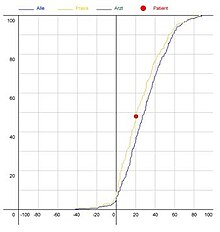APHAB
The APHAB Questionnaire ( A bbreviated P rofile of H earing A id B enefit ) is a 24 questions comprehensive questionnaire by which standardizes the subjective hearing or its impairment ( deafness ) can be evaluated in a patient. It was developed in 1995 by the Hearing Aid Research Laboratory (HARL) in Memphis (Tennessee) ( USA ). It was preceded by a questionnaire comprising 66 questions, hence the reference to "shortened". In particular in connection with a hearing aid supply , a benefit of the hearing aid can be demonstrated by improving the hearing ability in the various situations described. The APHAB questionnaire is available in many internationally used languages.
Structure and structure of the APHAB
With six questions each, the APHAB examines four different, standardized hearing situations before and after a patient receives hearing aids:
- EC scale: simple listening situations, dialogue in a quiet environment ( E ase of C ommunication )
- BN scale: listening with noise / background noise ( B ackground N oise )
- : RV-scale listening to language in rooms with reverberation / echo ( R e v heritage ration )
- AV scale: discomfort due to noise ( av ersiveness of sounds )
Evaluation of the questions by the patient
The APHAB questionnaire comprises 24 questions on everyday hearing situations, which must be answered before and after patients receive hearing aids on a 7-point scale from A to G. The categorical values A – G are then assigned numerical values (A: 0.99 B: 0.87 C: 0.75 D: 0.5 E: 0.25 F: 0.12, G: 0.01).
"A" means that the situation described in the question annoys the patient 99%, "G" means that 99% of the patient has no problems in this situation. Some questions are formulated inversely; they must be converted accordingly before the evaluation. The difference in the APHAB results before and after hearing aid fitting per question shows the benefits of the hearing aid in relation to the everyday situations described in the question. Overall, the associated differences are formed for all questions (attention: the inverse questions 1, 9, 11, 16, 19 and 21 must first be converted according to the scale). A mean value can then be calculated for each category (EC, BN, RV, AV) before and after the hearing aid is fitted. The benefit results from the difference between the corresponding value on a scale “not supplied” and “supplied”. An overall assessment for the scales EC, BN and RV with renewed averaging of all three values is possible. Likewise, the sum of the EC, BN and RV values, in the ratio of “benefit” to “unsupported”, multiplied by a factor of 100, can be shown as a percentage benefit (see following section).
Evaluation of the APHAB
The evaluation of the sheet determines the following values:
- ECx: Average APHAB score on the EC scale (listening in a quiet environment)
- BNx: Average APHAB score in the BN scale (hearing with background noise)
- RVx: Average APHAB score on the RV scale (hearing in a reverberant environment)
- AVx: Average APHAB score on the AV scale (hearing loud noises)
- The index “x” can have the following names
- x = u (unaided): VALUE of the corresponding APHAB scale before a hearing aid prescription
- x = a (aided): VALUE of the corresponding APHAB scale after hearing aid fitting
- x = b (benefit): [VALUE ("unaided" scale)] MINUS [VALUE ("aided" scale)]
This corresponds to the average benefit of the individual scales.
- Formulas to calculate the overall rating and improvement
- Overall assessment = (overall assessment without hearing aid) MINUS (overall assessment with hearing aid) = {[total (ECu, BNu, RVu)] DIVIDED 3} MINUS {[total (ECa, BNa, RVa)] DIVIDED 3}
The difference between the respective average values for the three scales is formed.
- Hearing improvement = overall rating {[SUM (ECb, BNb, RVb)] DIVIDED [SUM overall rating without hearing aid (ECu, BNu, RVu)]} x 100
The overall assessment of the benefit is related to the overall assessment without a hearing aid.
For each scale EC, BN and RV, an improvement of at least 5 percentage points must be achieved after hearing aid fitting, so that the hearing aid actually benefits from this scale.
APHAB inventory as part of a hearing aid supply
It is known that a speech intelligibility test for hearing aid wearers cannot predict the extent to which hearing aids can actually be of benefit to patients in all daily speech situations. Thus, questionnaire inventories like the APHAB have the potential to become another standard that proves the benefits of hearing aid integration. Therefore, they are also part of the services provided by statutory health insurance and the uniform assessment standard .
As part of the evaluation, it is possible to evaluate an individual patient against the background of a larger database, but also a doctor's practice against the population of the database.
literature
- RM Cox, GC Alexander: The abbreviated profile of hearing aid benefit. Ear Hear April 16, 1995, pp. 176-86
- RM Cox: The APHAB - Administration and Application Hearing Journal 1997, Vol. 50, pp. 32-48 ( PDF )
- JA Johnson JA, RM Cox, GC Alexander GC: Development of APHAB norms for WDRC hearing aids and comparisons with original norms. Ear Hear 2010, pp. 47-55
- J. Löhler, R. Frohburg, L. Moser: The use of the APHAB to measure the quality of hearing aid care in ENT practice. Laryngo-Rhino-Otol 2010; 89 (12): 737-744. doi : 10.1055 / s-0030-1261891
- J. Löhler, L. Moser, D. Heinrich, K. Hörmann, LE Walther: Clinical results in the application of the APHAB (German version) in the provision of hearing aids. ENT, July 2012, issue 60, issue 7, pages 626–636 doi : 10.1007 / s00106-011-2466-x
Web links
- QuIHz.de - (Quality assurance of the integrated hearing system supply in quality circles )
- The APHAB in German
- The APHAB in other languages
- Hearing Aid Research Laboratory (HARL), Memphis, TN, USA

